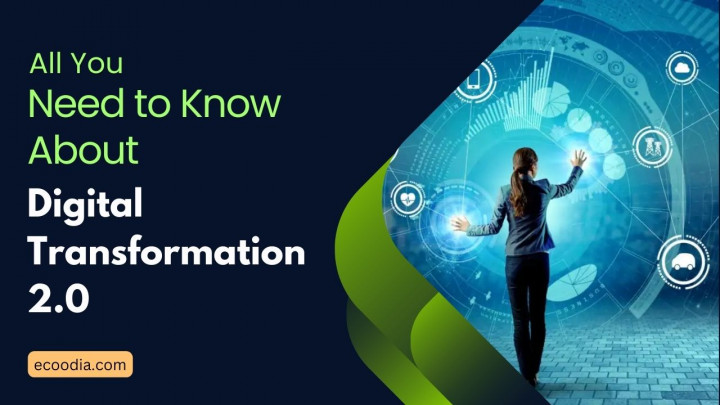All You Need to Know About Digital Transformation 2.0

The second wave of digital transformation, known as 2.0, expands on the first wave, which was centered on the adoption of digital technologies to improve customer experiences and streamline business processes. However, 2.0's approach to digital transformation is more comprehensive and is centered on utilizing cutting-edge technologies like augmented reality (AR), blockchain, Internet of Things (IoT), and artificial intelligence (AI) to fundamentally alter business models, procedures, and operations.
Following Are a Few Crucial Elements of Digital Transformation 2.0.
Accepting AI:
AI is at the forefront of the process of digital transformation according to 2.0. By analyzing a lot of data, artificial intelligence (AI) can assist
businesses in automating repetitive tasks, personalizing customer experiences, and coming to wiser decisions.
Decision-making Based On Data:
Data is the foundation of digital transformation 2.0. Businesses can learn more about consumer behavior, market trends, and operational inefficiencies by gathering and analyzing data. The use of this data can encourage innovation and help with strategic decision-making.
Customer Needs:
Customer centricity is a key component of digital transformation 2.0. Businesses can tailor their products and services to meet the needs of customers by understanding their needs and preferences. To collect customer insights and feedback, digital technologies like social media and customer analytics tools can be used.
Methodology For Agility:
Digital transformation 2.0 relies heavily on agile methodologies like DevOps and continuous delivery. By allowing companies to quickly test and iterate on new goods and services, these methodologies help them stay one step ahead of the competition and react quickly to shifting market conditions.
Cloud Computing:
A crucial enabler of digital transformation 2.0 is cloud computing. Businesses that use cloud-based technologies can scale their operations more quickly, cut costs, and enhance departmental and team collaboration.
Internet Safety:
Strong cybersecurity measures are required as our reliance on digital technologies grows. Cybersecurity is a top priority for digital transformation 2.0, ensuring that businesses are safeguarded against online threats and data breaches.
Read More: How CRM Helps Businesses Improve Customer Satisfaction
Pros And Cons Of Digital Transformation 2.0
- Pros Of Digital Transformation 2.0
- Cons of digital transformation 2.0
Pros Of Digital Transformation 2.0
Increased Effectiveness
To restructure business procedures, lessen manual labor, and boost productivity, 2.0 uses emerging technologies like AI, IoT, and automation.
Better Client Interactions
Businesses can use digital technologies to create targeted marketing campaigns, personalize customer experiences, and increase customer satisfaction and loyalty by adopting a customer-centric approach.
Innovation Growth
Businesses with digital transformation 2.0 gain a competitive edge in the market by being able to innovate more quickly, test new products and services, and launch them quickly to market.
Enhanced Data Insights
With the help of digital transformation 2.0, businesses can make data-driven decisions and enhance their operations by gathering and analyzing data to gain insights into customer behavior, market trends, and operational inefficiencies.
Increased Agility
Iterating on new products and services, responding quickly to shifting market conditions, and staying one step ahead of the competition are all made possible by agile methodologies like DevOps and continuous delivery.
Cons of digital transformation 2.0
Excessive Prices
For small and medium-sized businesses, digital transformation 2.0 requires significant investments in infrastructure, talent, and technology, which can be a barrier to entry.
Opposition To Change
The implementation of digital transformation 2.0 necessitates significant organizational and cultural changes, which may be met with resistance from staff members accustomed to conventional working practices.
Risks To Data Security And Privacy
As we rely more and more on digital technologies, we run the risk of data breaches and cyberattacks, which can have serious effects on our finances and reputation.
Gap In Skills
A skilled workforce that can work with cutting-edge technologies like AI, IoT, and blockchain is needed for digital transformation, but finding and training such a workforce can be challenging.
Possible Job Displacement
Some jobs may become obsolete as businesses automate and streamline their processes, which could cause job displacement and economic disruption.
Read More: What is Google Bard, why it Will Take Over ChatGPT
How Digital Transformation 2.0 Impacts Your Business
Your business may be significantly impacted by digital transformation 2.0, which can change how you run your operations, provide value to customers, and stay competitive. The following are some ways that digital transformation 2.0 can affect your company.
Increased Operational Efficiency
By automating tasks, utilizing AI, and implementing agile methodologies, digital transformation 2.0 can help you streamline your business processes, decrease manual effort, and increase efficiency.
Improved Client Experiences
Digital transformation 2.0 can assist you in embracing customer-centricity to help you develop targeted marketing campaigns,
personalize customer experiences, and increase customer satisfaction and loyalty.
An Increase In Innovation
Giving you a competitive edge in the market, digital transformation 2.0 can assist you in innovating more quickly, testing new goods and services, and bringing them to market more quickly.
Improved Data Insights
You can gather and analyze data with the aid of digital transformation 2.0 to learn more about consumer behavior, market trends, and operational inefficiencies. This will help you make data-driven decisions and enhance your business operations.
Greater Flexibility
By implementing agile methodologies like DevOps and continuous delivery, digital transformation 2.0 can help you react quickly to shifting market conditions, iterate on new products and services, and stay one step ahead of the competition.
But there are some drawbacks to digital transformation 2.0 for your company as well. For instance, it might necessitate sizeable investments in infrastructure, talent, and technology, which might be a barrier for small and medium-sized businesses to overcome.
Additionally, putting digital transformation 2.0 into practice necessitates significant organizational and cultural changes, which may be met with resistance from staff members accustomed to conventional working practices. Finally, the increased reliance on digital technologies entails a risk of data breaches and cyberattacks, which could have severe financial and reputational repercussions for your company.
Read More: Why Bing's New Chatbot Is Put To The Test 2023
Future Of Digital Transformation 2.0
The future of digital transformation is both exciting and challenging. The transformation of businesses, products and services will continue to be driven by new technologies and changing customer expectations. In the future of digital transformation, the following trends and developments may be influential.
Artificial Intelligence (AI) and Machine Learning (ML)
AI and ML will continue to change how businesses operate by allowing them to automate processes, gain insights from data, and improve their judgment.
Internet of Things (IoT)
IoT will continue to revolutionize the way companies collect and analyze data from connected devices, allowing companies to optimize operations and deliver solutions to problems. deliver new value to their customers.
Blockchain
The adoption of blockchain technology is expected to increase in many industries, enabling secure and open collaboration and transactions.
Cloud Computing
Cloud computing will continue to play an important role in businesses' digital transformation by enabling them to use scalable and affordable computing resources affordable to support their innovation projects and day-to-day operations.
Cybersecurity
As businesses become increasingly reliant on digital technologies, cybersecurity will remain a top priority. To better protect against cyber threats, new technologies such as AI-based security solutions will be developed. Human-machine collaboration is essential for organizations to increase productivity and innovation as AI and automation become more pervasive.
Green and Sustainable Technologies
Promoting sustainability will impact digital transformation as companies create new tools and techniques to reduce their environmental impact and help transition to digital transformation. low carbon economy.
Conclusion
Digital transformation 2.0 represents a shift from using digital technologies to improve existing processes to using digital technologies to fundamentally transform businesses and create new value propositions. By embracing emerging technologies, data-driven decision-making, and customer-centricity, businesses can stay ahead of the competition and thrive in the digital age.
Read More: The US Housing Market Posts a $2.3 Trillion Drop, The Biggest Since The 2008 Crisis
